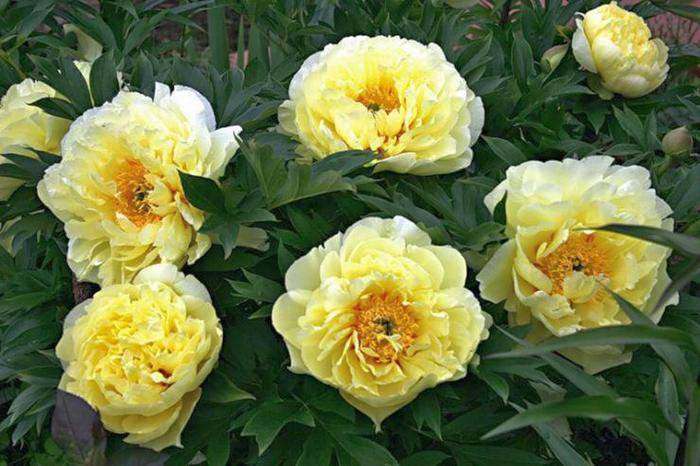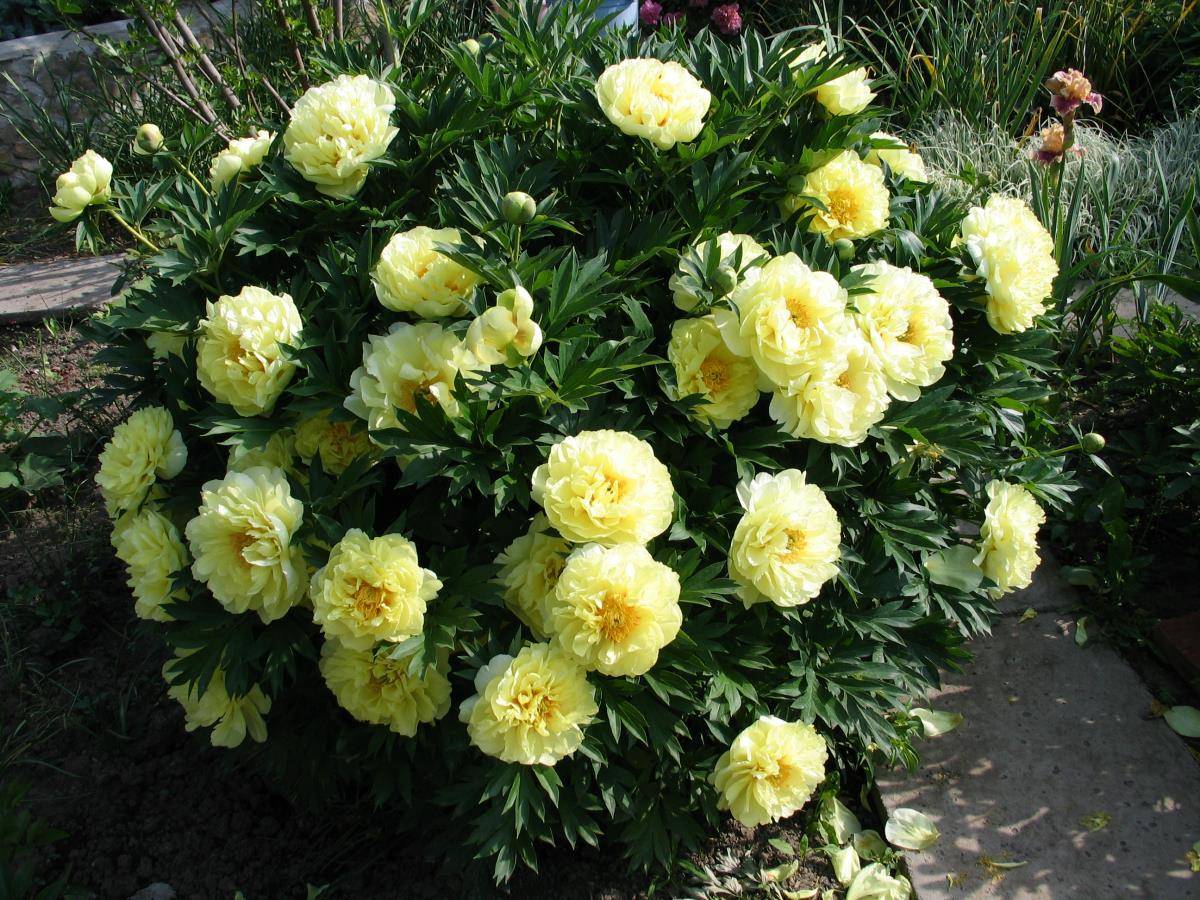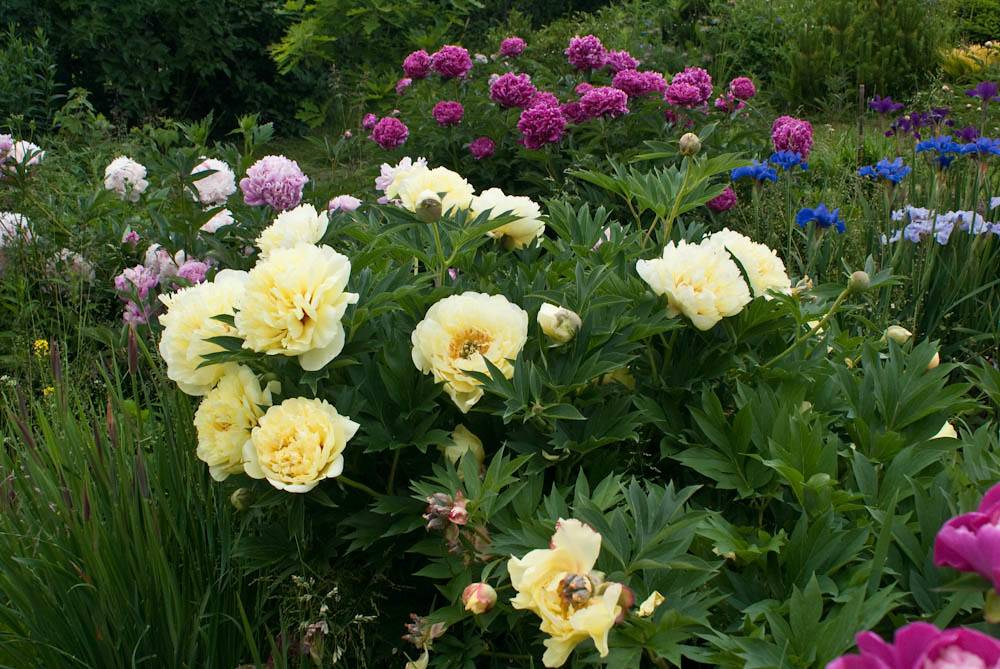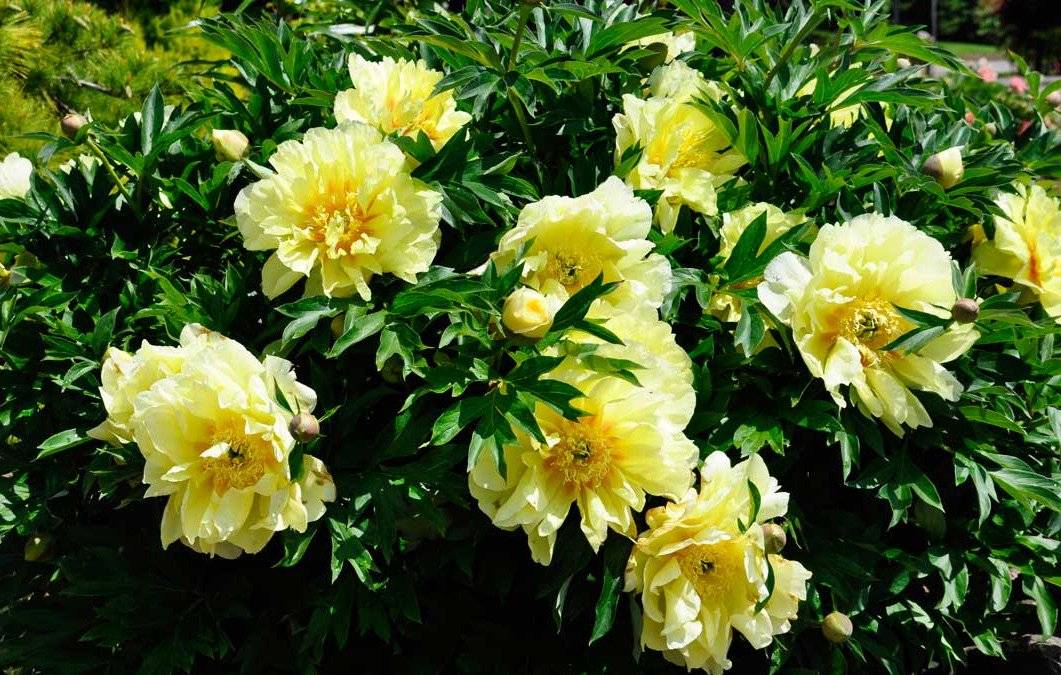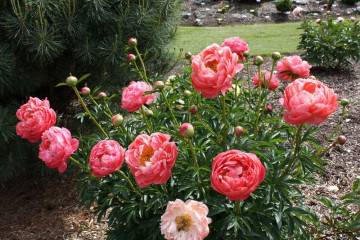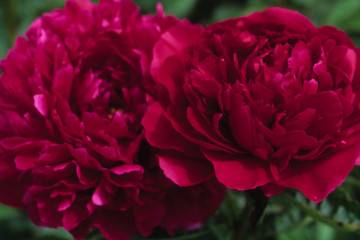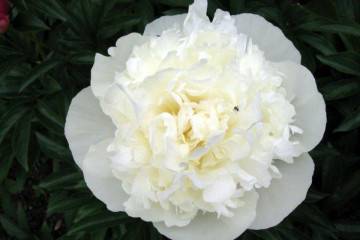Peony Yellow Crown (Paeonia Yellow Crown)
Content:
Yellow-headed peonies (paeonia) were not given to breeders for a long time. All attempts ended with the yellow petals quickly turning white in the sun. Much later, in the middle of the last century, it was finally possible to obtain a flower with sunny buds. One of these varieties will be discussed below.
Peony Yellow Crown (Paeonia Itoh Yellow Crown) - what is this variety
The creator of the new hybrid is a scientist from the land of the rising sun, T. Ito. The tree-like and herbaceous peonies became the progenitors of the newcomer. Since then, golden peonies have begun their triumphant march around the world.
The new plant is distinguished by long-term development in one place. Over the years, the bush becomes more voluminous. If the location is well chosen, the crop will be covered with a cap of yellow buds annually.
For the purpose of reproduction, it is recommended to use the rhizome of a young bush. It is better not to touch a plant older than 4 years. The roots turn to stone by this age, and it is impossible to cut them.
Brief description and characteristics
Yellow peonies are quite tall. An adult plant grows up to almost a meter. The entire aerial part (stems, leaves) of the hybrid is dark green. With the onset of frost, it dies off (the influence of the species of herbaceous peony). Bright yellow buds are double and semi-double at least 18-21 cm in diameter.
Advantages and disadvantages of the variety
The advantages of the ITO-hybrid include:
- lush bloom;
- disease resistance;
- frost resistance;
- wonderful aroma;
- decorativeness throughout the growing season.
Disadvantages of the variety:
- the location of the buds among the leaves, where they are not visible;
- the appearance of non-double flowers;
- color change and the appearance of patterns on the petals;
- high cost of seedlings.
Use in landscape design
Blooming peony Yellow Crown itself is already a decoration of any site. You can use it in design with almost any plants, only the rules for their content must coincide.
When creating a flower bed or any other composition, consider:
- this hybrid is a perennial and takes up a lot of space;
- does not tolerate waterlogged soil;
- loves open, sunny areas, protected from strong winds;
- comes into bloom only after 3-4 years;
- needs support, as the flowers are large and heavy.
The bush can be planted in the center of a round flower garden and planted stepwise in a circle with medium-sized and low-growing crops (badan, poppies, tulips, daffodils, etc.).
Curbs and garden paths lined with yellow peonies look good. By changing companion plants, you can get a new design every year.
In general, a huge number of colors can be combined with a hybrid. For example, in flower beds they are suitable:
- lilies, daylilies;
- phlox;
- astilbe;
- chrysanthemums;
- asters;
- chamomile;
- petunias;
- gladioli;
- spireas;
- irises;
- hydrangeas.
Growing a flower
Correct landing primarily implies choosing the best place. In the future, proper care will be required.
Planting by root cuttings
Only young specimens reproduce by root cuttings. For this:
- A bush is being dug up.
- It is cut into pieces so that each one has several shoots.
- The slices are sprinkled with crushed charcoal or cinnamon powder.
- The parts are planted in the finished holes.
What time is the boarding
If desired, the hybrid can be planted in spring and autumn. Florists are advised to carry out work in early spring before the start of the growing season. Before winter, the plant will take root well and get stronger.
Seat selection
The yellow peony, although a voluminous bush, is still a grass, therefore it does not tolerate strong gusts of wind. Also, for good flowering, it needs maximum sunlight.
As a perennial that grows in size every year, the Yellow Crown peony develops better away from large plants. For the same reasons, it should initially be planted in a wide and deep (about 1 × 1 m) planting pit, at a great distance from groundwater.
How to prepare the soil and flower for planting
The flower will grow in one place for many years, so fertile soil is initially required. The composition of the following will be optimal for him:
- humus (compost) - 20-30 l;
- wood ash - 0.5-0.7 kg;
- mineral phosphorus fertilizers (for example, superphosphate) or potassium sulfate, 200 g each.
The mixture is thoroughly mixed with the excavated soil.
Next, a peony for division is selected and dug out.
Step by step process:
- The peony is carefully dug up.
- The roots are freed from the ground.
- The rhizome is divided into parts so that each root piece has 3 or more buds.
Planting procedure step by step
Planting a culture looks like this:
- A young plant is placed in the center of the finished pit and covered with earth.
- In conclusion, the soil near the bush is rammed, watered and mulched.
Planting with seeds (for breeding)
It is possible to grow ITO Yellow Crown peony from seeds, but it is not known which flower will grow. Varietal characteristics are almost never preserved. The process itself is quite long and complicated. Sometimes sprouts have to wait up to five years.
The seeds themselves should be collected unripe (in mid-August), stratified. To do this, they are placed in a moist substrate (for example, sand) and heated to a temperature of 30 ° C. Then the crops are cooled for 24 hours in the refrigerator and heated up again.
With a successful outcome at the end of 3 months, the seeds hatch. Then they are planted in peat for another 3 months and kept at a temperature of 5 ° C to 10 ° C.
Seedlings with real leaves are exposed in a bright, warm place before planting in open ground.
Plant care
For the first three years, the plant is considered young and needs more gentle care. This is more related to preparation for wintering.
Watering and feeding
Bushes of all ages need regular watering depending on the weather conditions.
Starting from the third year, it is recommended to apply phosphorus and potassium fertilizers. The most suitable period is the beginning of budding.
Mulching and loosening
It is advisable to combine watering with weeding and loosening. Loosening will help increase aeration of the roots, and weeding will protect against pests and fungal diseases. It will also give the bush an aesthetic look.
Mulching will serve as an additional top dressing and will not allow moisture to evaporate quickly.
Preventive treatment
In order to protect against pests and diseases, the seedlings themselves are already processed. It is recommended to immerse it in the solution for half an hour:
- copper sulfate;
- means of maxims;
- potassium permanganate.
Garden bushes, or rather the soil under them, is watered with Bordeaux liquid.
Proper care will also help protect your plants.
Blooming peony ITO Yellow Crown
The first buds on the bush appear in mid-June. The flowering period is quite long. New flowers on some varieties of Yellow Crown ITOH peony can appear within one month.
A period of activity and rest
The culture becomes more active at the beginning of spring (at the end of April). The bushes go to rest with the first frosts.
Care during and after flowering
Before budding, you need to fertilize, water, weed, loosen.
Dried buds are cut to the first leaf. Non-flowering branches are left intact for about a month. Buds will be laid on them and buds will form. For greater tillering, stepchildren are cut off on the branches.
What to do if it does not bloom
For the first time, a yellow peony blooms in 3-4 years. If the buds have not appeared by this age, mistakes in choosing a place and improper care are possible. If flaws are eliminated in time, an adult bush will increase the number of stems, that is, it will become bushy. When several buds appear in the current season, it is better to cut them off. So the peony will become much stronger to delight with flowering next season.
Peonies after flowering
The main work on the preparation of the ITO hybrid for the next season is carried out after flowering in the current one.
Transfer
Not very old bushes, not older than 4 years, can serve as breeding material for culture. At the same age, they can be transplanted to a new place without dividing.
Pruning
Before the first frosts, the aerial part of the peony is cut at a height of 10-20 cm from the ground level.
Preparing for winter
Adult plants are not afraid of frost. You don't need to cover them. Young bushes (up to 3 years old) are recommended to be covered. Before the onset of frost, they should be sprinkled with peat (sawdust, dry foliage, humus) and covered with spruce branches (you can use a covering material).
Diseases, pests and ways to control them
Peony ITO Yellow Crown is quite resistant to various lesions. However, inadequate care can lead to serious consequences.
Most often, the culture becomes infected:
- rust;
- gray rot;
- brown spot (cladosporium);
- brown spot (septoria);
- root rot;
- powdery mildew;
- circular mosaic of leaves;
- Lemoine's disease.
If a disease is detected, it is immediately recommended to collect the affected areas and burn. Sometimes you have to destroy the entire plant. To avoid this, preventive treatments with appropriate drugs will help.
Yellow peony pests:
- aphid;
- bronze beetle;
- root-knot nematodes;
- ants;
- thrips;
- hop thinworm.
A soap solution or treatment with insecticides such as actellik, fitoverm, confidor, etc. will help to deal with them.
With all the complexity of breeding and the high cost of planting material, gardeners are eagerly engaged in the cultivation of this variety. The charming perennial more than justifies all the costs. Sunny, fragrant buds win hearts forever.
